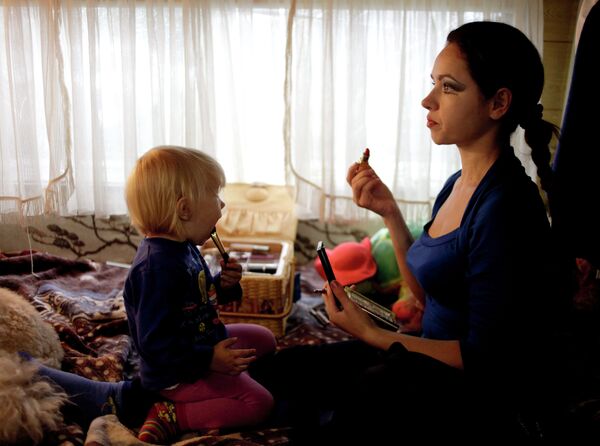For circus performers, home is where the trailer goes. This week Moscow’s Circus Koudzinov raised its big top in Khimki, a small town just outside Moscow. The troupe is performing in the area for two weeks before leaving for its next location.
It is an unpredictable life, but performers like Oxana Koudzinova, 30, are used to it.
“I was born into the circus,” says Oxana, carefully slipping into a royal-blue sequence dress and clipping on a pair of matching sparkling earrings. “It’s all I know. My parents performed and now manage the circus, and I’ve followed their path.”
Her family’s modest trailer comes equipped with a cozy eat-in kitchen, a small flat screen television and a cubicle-like bedroom, which she shares with her husband and daughter, Evelina, who has not yet reached her second birthday but is already being groomed for circus life.
Nataliya Koudzinova, 47, is the matriarch of Circus Koudzinov, a traveling band of men, women, children and animals that races between Moscow’s suburbs, playing a show a day for two weeks or more throughout the summer. Koudzinova trained at a circus school in Tashkent, where she met her husband, Vasily. The two used to perform together until last year. Now Koudzinova spends most of her time watching from outside the ring.
“We saved up all our money to open our own circus. It is a family dynasty that we’d like to preserve,” Koudzinova says proudly. “My daughter is a performer and we expect her daughter to follow in our footsteps. It is very much a family business.”
Family ties are apparent throughout the entire outfit. The clown is married to the flying gymnast, who is almost 20 years his senior. The bird tamer is involved with the master of ceremonies, and to add to the amour even each dog has a partner or two. It may sound bizarre, but Koudzinova says it is all part of circus life.
“It’s not easy to live on the road like this,” says Koudzinova, pointing to their camping site. “These artists trade their normal life for one on the road. We’re like gypsies, performing and traveling around the country.”
The traveling circus is straight from a picture book: the clown, the trapeze, the dancing dogs and bears, and of course, the big top. The 18th century creation, which can be traced back to Ancient Rome, is very much frozen in a time, long before the high-concept, high-dollar Cirque du Soleil, which plans to visit Moscow again this year. But the dwindling crowds jar with the picture book imagery.
“There are fewer and fewer people coming to see the circus,” says Koudzinova. “The idea of an independent traveling circus is a new phenomenon; we didn’t have this in the Soviet Union. It’s great because this freedom allows us to create our own business, but then again, when you don’t have a crowd, it makes it pretty hard to stay afloat.”
Circus Koudzinov, one of a handful of traveling circuses that occupy a precarious niche in national entertainment, first began performing a year ago. With its tiny budget and cast, the troupe has only managed to profit from a few of its performances in its first season. Usually it draws in a small crowd of around 100 people per performance, one sixth of the tent’s capacity.
The owners of Circus Koudzinov blame Moscow’s scorching summer for the dismal turnout. But other circus owners in the city believe the low attendance may have more to do with the way traveling circuses are marketing themselves.
“Every year, there are more and more traveling circuses opening,” says Edgar Zapashny, a travelling circus performer turned entrepreneur who now makes millions running the Zapashny Brother Circus in Moscow. “If a circus does not invest a lot of money in its program, it will suffer. People don’t pay attention to advertisements anymore, so if a circus doesn’t make a name for itself, it won’t have an audience.”
With their first season drawing to a close, the owners of Circus Koudzinov are making plans for next year’s season, when they hope to attract a bigger crowd. Although the company will not have any flashy stars or modern flourishes, the owners say they are proud to be able to utilize old standards and maintain traditions, which is certainly enough to keep some circus-goers coming back for more.
“We heard that the traveling circus set-up in our neighborhood, so we quickly bought tickets,” says Yelena Tiganova, who lives only a few blocks away from the circus. “It was a big deal for my daughter. She carefully picked out her outfit and was delighted to see the clown. Now every time we pass the tent, she asks: ‘Can we go to the circus again?’”
By: Diana Markosian

